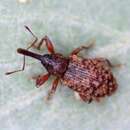en
names in breadcrumbs


Dorytomus taeniatus is a species of weevil native to Europe.[2][3] It was first described by Johann Christian Fabricius in 1781. The larvae cause a small growth (known as a gall) on the catkins of willows (Salix species).
Eggs are laid during the autumn in the axils of catkin buds and hatch the following spring.[4] The larvae cause an inconspicuous distortion of, usually, female catkins, thickening the rachis.[5] Catkins drop earlier than uninfected catkins and the larvae pupate in the soil.[6] Close examination of the gall is necessary as Redfern et al. (2011) note that sometimes, thickening of the rachis can be wound tissue rather than a gall and according to Plant Parasites of Europe identification is only possible by examining the weevils.[5][6]
The gall has been recorded from white willow (S. alba), eared willow (S. aurita'), goat willow (S. caprea), grey willow (S. cinerea) and purple willow (S.purpurea).[6]
Adults are 4–5 millimetres (0.16–0.20 in) long and brownish-black to black. They can be found from May onwards, browsing on the leaves, removing patches of tissue and exposing the network of fine veins.[4]
Found in western and central Europe including Great Britain (common) and Scandinavia.[7]
Dorytomus taeniatus is a species of weevil native to Europe. It was first described by Johann Christian Fabricius in 1781. The larvae cause a small growth (known as a gall) on the catkins of willows (Salix species).